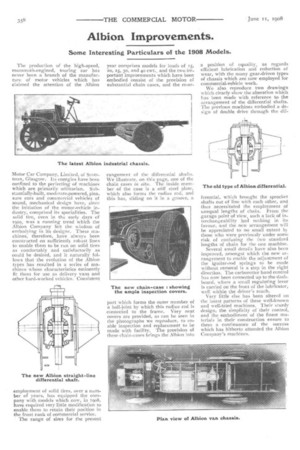Albion Improvements.
Page 4

If you've noticed an error in this article please click here to report it so we can fix it.
Some Interesting Particulars of the 1908 Models.
The production of the high-speed, mammoth-eng-ined, touring car has never been a branch of the manufacture of motor vehicles which has claimed the attention of the Albion
Motor Car Company, Limited, of Scots. toun, Glasgow. Its energies have been confined to the perfecting of machines which are primarily utilitarian. Substantially-built, moderate-powered, plea_ sure cars and commercial vehicles of sound, mechanical design have, since the initiation of the motor-vehicle industry, comprised its specialities. The solid tire, even in the early days of Two, was a running tread which the Albion Company felt the wisdom of embodying in its designs. These machines, therefore, have always been constructed on sufficiently robust lines to enable them to be run on solid tires as comfortably and satisfactorily as could be desired, and it naturally follows that the evolution of the Albion types has resulted in a series of machines whose characteristics eminently fit them for use as delivery vans and other hard-worked vehicles. Consistent
employment of solid tires, over a number of years, has equipped the cornpany with models which now, in 1908, have required very little modification to enable them to retain their position in the front rank of commercial service.
The range of sizes for the present
year comprises models for loads of Ts, 20, 25, 30, and 4.o cwt., and the two important improvements which have been embodied consist of the provision of substantial chain cases, and the re-ar rangement of the differential shafts. We illustrate, on this page, one of the chain cases in situ. The inside member of the case is a stiff steel plate, which also forms the radius rod, and this has, sliding on it in a groove, a
part which forms the outer member of a ball-joint by which this radius rod is connected to the frame. Very neat covers are provided, as can be seen in the photographs we reproduce, to enable inspection and replacement to be made with facility. The provision of these chain-cases brings the Albion into a position of equality, as regards efficient lubrication and reduction of wear, with the many gear-driven types of chassis which are now employed for commercial-vehicle work.
We also reproduce two drawings which clearly show the alteration which has been made with reference to the arrangement of the differential shafts. The previous machines embodied a design of double drive through the dif ferential, which brought the sprocket shafts out of line with each other, and thus necessitated the employment of unequal lengths of chain. From the garage point of view, such a lack of interchangeability had nothing in its favour, and the new arrangement will be appreciated to no small extent b), those who were previously under some risk of confusing the two standard lengths of chain for the one machine.
Several small derails have also been improved, amongst which the new arrangement to enable the adjustment of the igniter-rod springs to be made without removal is a step in the right direction. The carburetter hand control has now been connected up to the dashboard, where a small regulating lever is carried on the front of the lubricator, well within the driver's reach.
Very little else has been altered on the latest patterns of these well-known and well-tried machines. Their sturdy design, the simplicity of their control, and the embodiment of the finest materials in their construction ensure to them a continuance of the success which has hitherto attended the Albion Company's machines.




















